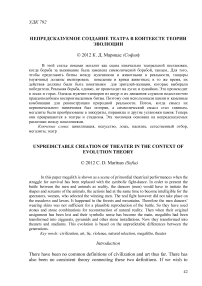Unpredictable creation of theater in the context of evolution theory
Автор: Maritsas Constantinos D.
Журнал: Креативная экономика и социальные инновации @cesi-journal
Рубрика: Социологические и психологические исследования
Статья в выпуске: 2 (3), 2012 года.
Бесплатный доступ
In this paper megalith is shown as a scene of primordial theatrical performances when the struggle for survival has been replaced with the symbolic fight-dance. In order to present the battle between the men and animals as reality, the dancers (men) would have to imitate the shapes and screams of the animals, the actions had at the same time to become intelligible for the spectators, women, who selected the winning men. The real fight however did not take place on the meadows and lawns. It happened in the forests and mountains. Therefore the men dancers’ wearing skins was not sufficient for a plausible reproduction of the battle. So they have used stones and stone combinations for reconstruction of natural reality. Then when their original assignment has been lost and their symbolic sense has become the main, megaliths had been transformed into ziggurats, pyramids and other stone installations. Now they transformed into theaters and stadiums. This evolution is based on the unpredictable differences between the generations.
Civilization, art, lie, violence, natural selection, megaliths, theater
Короткий адрес: https://sciup.org/14238931
IDR: 14238931
Список литературы Unpredictable creation of theater in the context of evolution theory
- Bronowski J. (1987). The evolution of human (Η εξέλιξη του ανθρώπου). Athens: Orora.
- Darwin Ch. (1997). The origin of the species (Η Καταγωγή των Ειδών). Patra Hellas: University of Patra Press.
- Davis W. (2011), A general theory of Visual Culture. Princeton NJ: Princeton University Press.
- Deleuze G. & Guattari F., (Делез Ж. & Гваттари Ф). (1998), What is Philosophy? (Что такое философия?). -S.Peterburg: Aleteyl (Алетейя).
- Gaarder J. (1994), The world of wisdom (Ο Κόσμος της Σοφίας), Athens: Nea Sinora.
- Glesos M. (1977), The Phenomenon of Language Alienation (Το φαινόμενο της αλλωτρίωσης της γλώσσας), Athens: Vegas.
- Har M. (1998), The work of art (Το έργο τέχνης), Athens: Scriptra.
- Harrison J. E. (1913), Ancient Art and Ritual, London, Thornton Butterworth Ltd.
- Heidegger M. (1986), The origin of the work of art (Η καταγωγή του έργου τέχνης), Athens: Dodoni.
- Huizinga (Хейзинга Й.) (1997), Homo Ludens; (Статьи по истории культуры, trans. ст. Д. В. Сильвестрова, Коммент. Д. Э. Харитоновича), Moskow: Progress:Traditsia (Прогресс-Традиция).
- Leroi-Gourhan A. (1993). The religions of prehistory (Οι θρησκείες της προϊστορίας). Athens: Kardamitsa.
- Maritsas C., (Μαρίτσας Κ.) (2003), Civilization and natural selection (Πολιτισμός και φυσική επιλογή). Athens: Arsenidis.
- Maritsas C. (Μαρίτσας Κ.) (2007). Civilization and natural selection 2 (Πολιτισμός και φυσική επιλογή 2). Sofia: Sofia University Press.
- Morris D. J., Human Observation -Human Behavior (Ανθρωποπαρατήρηση), Athens: Arsenidis.
- Morris D. J. (1970). The naked ape. (Ο γυμνός πύθικος) Athens: Kedros.
- Peters J., & Schmidt K. (2004). Animals in the symbolic world of pre-Pottery Neolithic Gobekli Tepe, south-eastern Turkey: A preliminary assessment. Anthropozoologica, 39(1), 179-218.
- Taine H. (1998). Philosophy of art (Φιλοσοφία της τέχνης), Athens: Govostis.


